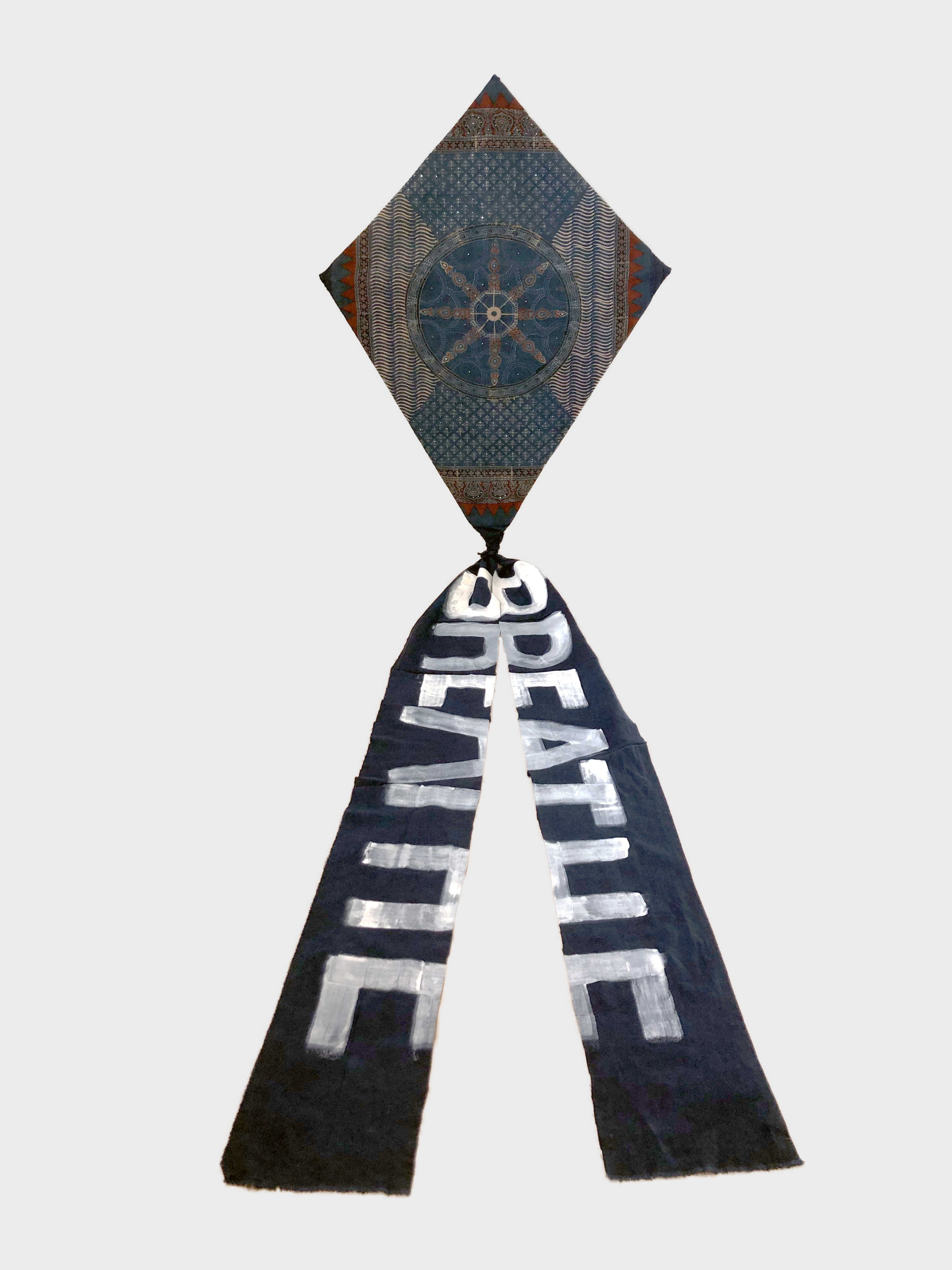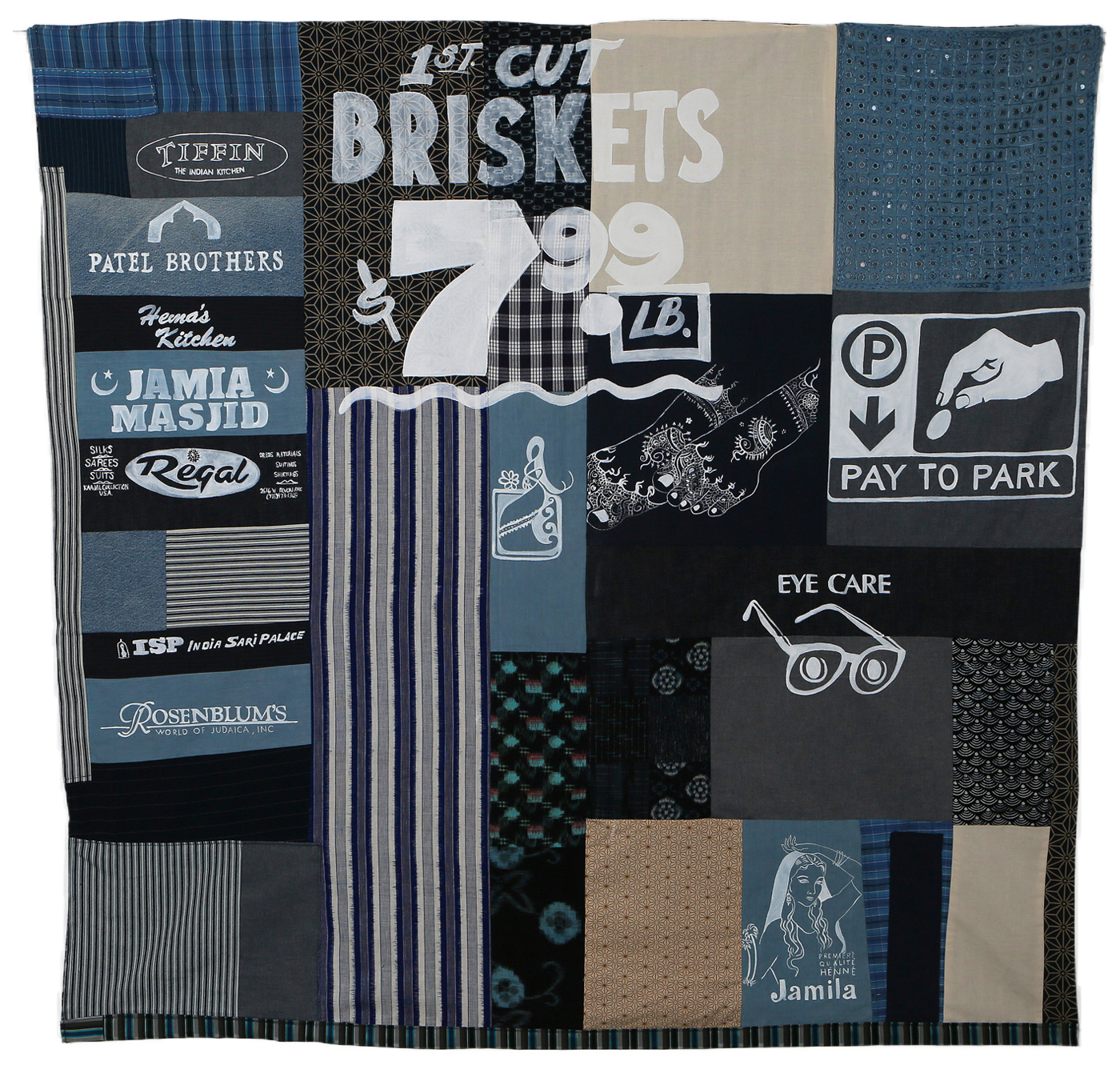Laura Kina and Shelly Jyoti
United States of America + India

Laura Kina and Shelly Jyoti
EPOCH 2020: Breathe, 2021
Ajrakh printing, dyeing, and needlework
on hand-spun, handwoven khadi fabric,
indigo natural dye, and acrylic paint
Kite: 50" x 37”; Tail: 72"
Laura Kina and Shelly Jyoti came together in 2021 to collaborate on EPOCH 2020: Breathe to address the current COVID-19 crisis. The work takes the form of a grounded/sculptural kite. Jyoti created the fabric for the kite utilizing a textile tradition of reverse block printing with natural dyes called ajrakh, a 4,500-year-old technique originally practiced by the Indus Valley Civilization. In the centerpiece of the kite is a spinning wheel that is both a metaphor for the continuity of life and a reference to Gandhi’s spinning wheel. Hand embroidered thread work forms wave patterns to gesture at a continuous process of movement. Tiny mirrors cover the surface of the fabric to symbolize how the coronavirus keeps mutating. Kina fashioned Jyoti’s textile into a kite and added a tail with “Breathe” painted in bold white block text. The Breathe is cut into two strips to symbolize both the act of breathing in and out and the struggle to survive amid the ongoing global public health crisis.

Shelly Jyoti
Illusion to Ajrakh: An Indigo Sapling, 2012
Ajrakh printing, dyeing, and needlework on khadi fabric
50" x 70"

Laura Kina
Devon Ave. Sampler: Golda Meir/Gandhi Marg, 2009
Hand embroidery on khadi fabric
16" × 40"

Laura Kina
Devon Avenue Sampler: Pay to Park, 2011
Acrylic paint on hand-sewn quilt
60" x 60"
From 2009-2014, Shelly Jyoti and Laura Kina’s two-woman show Indigo traveled to galleries and cultural institutions in India and the United States. Three of their works from this show are on display in this exhibition. Employing fair trade artisans from women’s collectives in India and executing their works in indigo blue, Indian artist Shelly Jyoti and U.S. artist Laura Kina’s works draw upon India’s history, narratives of immigration and transnational economic interchanges. Shelly’s Indigo Narratives refers to India’s history of 19th century indigo farmers, their oppression in deltaic region, and Mahatma Gandhi’s subsequent non-violent resistance that began India’s freedom struggle (Champaran movement 1917-18).
The works utilize indigo resist dyeing/printing on khadi fabric with the 9th-10th generation ajrakh craftsmen of Gujarat and traditional embroidery by rural women in Bhuj (Gujarat) with support of Shrujan: Threads of Life. Laura’s work from her series Devon Avenue Sampler: Golda Meir/Gandhi Marg was hand embroidered by artisans from MarketPlace: Handwork of India, a fair trade women’s organization in Mumbai, India.
about the artists

Shelly Jyoti has an academic background in English literature, and formal training in fashion designing and clothing technology. Her artworks interconnect art, design, and critical theories. Jyoti’s art practice centers around building moral, peaceful, and ethical societies with focus on Gandhi’s philosophies of nation building relevant for the 21st century through nationalist narratives. She searches for historical iconographic elements and constructs the hermeneutics of period histories, its contemporary representation and sociopolitical enquiry into singular aesthetic experience. Jyoti collaborates with the 9th or 10th generation of Ajrakh artisans who migrated from Sindh and Baluchistan in 1600 CE, but still carry on 4,500-year-old textile traditions of printing and dyeing in Bhuj, Gujarat. Invoking the heritage of Ajrakh textile tradition on khadi fabric that expresses qualities of self-purification, self-reliance symbolically, she is exploring how textiles – both as material objects that have lineage of India's freedom struggle and because of their artistic form – can be used to stitch communities together. Her works examine Gandhi’s message to humanity, struggle of India’s independence, exploration with heritage textile tradition, engagement with craft communities celebrating the subaltern, and reasons to empower individuals. Gandhi said, “The best way to find yourself is in the service of others.”
shellyjyoti.com
shellyjyoti.com

Laura Kina is a mixed-race Okinawan American artist-scholar based in Chicago. She is a Vincent de Paul Professor at The Art School at DePaul University. Contemporary Asian American art; Okinawan, mixed race, and critical ethnic studies; and feminist/queer theory form the nexus of her intersectional art and scholarship. In 2020, she was awarded an ART Matters Foundation fellowship, and she is a 2019 Joan Mitchell Foundation Artist-in-Residence award recipient. Laura has exhibited at India Habitat Centre and India International Centre, Nehru Art Centre, Okinawa Prefectural Art Museum, Chicago Cultural Center, Japanese American National Museum, Rose Art Museum, Smithsonian Archives of American Art, Spertus Museum, and Wing Luke Museum of the Asian Pacific American Experience, among others. Laura is co-editor of Queering Contemporary Asian American Art (University of Washington Press, 2017) and War Baby/Love Child: Mixed Race Asian American Art (University of Washington Press, 2013). In 2019, Bess Press published her trilingual (Pidgin/Japanese/Uchinaaguchi) illustrated children’s book Okinawan Princess: Da Legend of Hajichi Tattoos written by Lee A. Tonouchi. She serves as reviews editor for the Asian Diasporic Visual Cultures and the Americas (Brill) and series editor for Critical Ethnic Studies and Visual Culture (University of Washington Press).
laurakina.com
laurakina.com
interview